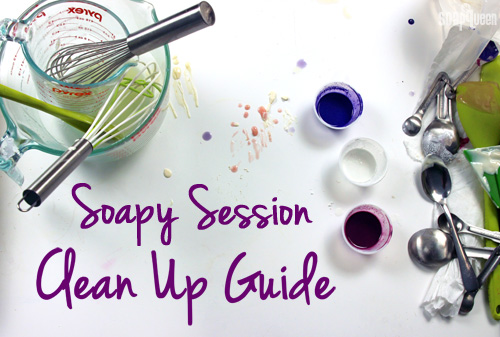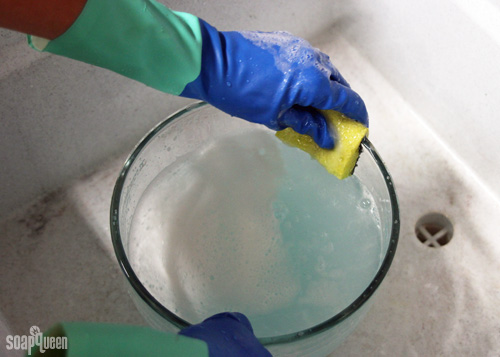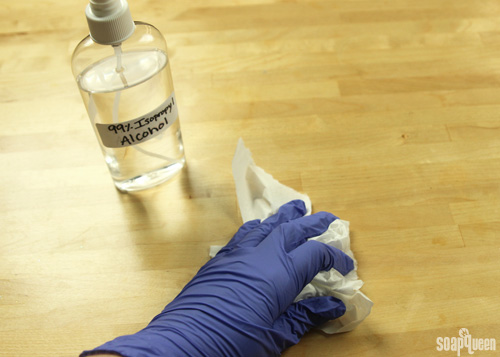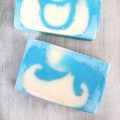Ask soapers what their favorite part of soaping is, and the answers will be diverse. Ask soapers what their least favorite part is, and the large majority will answer, “The cleanup!” It’s true, cleaning up after a soapy session is not particularly enjoyable. Luckily, with a little hot water, grease-cutting soap, a sponge and gloves, it’s easy!

There are two different ways to clean up after soaping. The first involves placing all the tools into the sink, and scrubbing the ol’ fashioned way. The other, involves a garbage bag and cuts down on oils going down the sink.
When cleaning up, it’s important to wear gloves to protect your hands. While most of the saponification has already happened, the soap batter can still irritate the skin. Some soapers like to wear goggles while cleaning up as well. An apron is also a good idea =)

Sink and Soap Method
Use a spatula to scrape as much soap batter into the mold as possible. Wipe leftover raw soap from bowls and utensils with paper towels and throw away in the garbage. Eliminating soap batter before washing in the sink cuts down on oils and lye going down your pipes. Wiping up extra soap batter before washing in the sink is a great precaution if your pipes are old, or have a septic tank. While soap batter oils accumulating on pipes is uncommon, it is possible.
To prevent clogging, use extremely hot water and a grease-cutting dish soap. The great thing about homemade soap is it is gentle on the skin. In this case, the opposite is desired! A grease cutting, surfactant dish soap helps cut through the oils, and prevents greasy residue on your bowls and utensils. In the soap lab, we use Dawn.
Once excess soap has been removed, gather all containers, bowls and utensils and transfer them to an empty sink. Turn the water to high heat, and fill the bowls and containers with water and dish soap. While the bowls are soaking, begin washing the utensils using grease-cutting dish soap and a sponge specifically for soaping utensils.
 To clean the stick blender, submerge the head of the stick blender into the bowl filled with hot soapy water, and turn the stick blender on. Doing so helps remove the soap inside the blender head. Rinse thoroughly with clean, hot water.
To clean the stick blender, submerge the head of the stick blender into the bowl filled with hot soapy water, and turn the stick blender on. Doing so helps remove the soap inside the blender head. Rinse thoroughly with clean, hot water.
Once the blender is clean, use a sponge specifically for washing soapy tools to scrub the bowls and containers. Rinse thoroughly to ensure all soap is removed. Once finished, scrub the sink completely using dish soap.


Note: Some soapers like to soak their tools in a bleach or vinegar solution after soaping. I’ve found hot water and dish soap has always done the trick!
The Garbage Bag Method
For soapers who want to avoid washing any oils down the sink, the garbage bag method of cleanup is a great option. Once done soaping, place all the soaping bowls and utensils into a large, heavy duty garbage bag.
 Tie the garbage bag closed, and place the bag in an area where it will not be disturbed by family or pets. The garage, laundry room or outside may be great places to leave the garbage bag. Allow the bag to sit for 48-72 hours. During this time, the leftover soap will begin to saponify and harden. Basically, it becomes soap in the containers!
Tie the garbage bag closed, and place the bag in an area where it will not be disturbed by family or pets. The garage, laundry room or outside may be great places to leave the garbage bag. Allow the bag to sit for 48-72 hours. During this time, the leftover soap will begin to saponify and harden. Basically, it becomes soap in the containers!
 Once the soap has hardened, scoop the soap out of the containers using a spatula. Some soapers throw the leftover soap away, or find a project to incorporate it into. One option, is to use the leftover soap to create laundry soap.
Once the soap has hardened, scoop the soap out of the containers using a spatula. Some soapers throw the leftover soap away, or find a project to incorporate it into. One option, is to use the leftover soap to create laundry soap.

 No matter what cleaning method you prefer, thoroughly wipe down your soaping surface with your favorite cleaning solution, or rubbing alcohol.
No matter what cleaning method you prefer, thoroughly wipe down your soaping surface with your favorite cleaning solution, or rubbing alcohol.
 Now that your soap making area is clean…it’s time to soap again! 😉 Do you have any soapy clean up tips? I would love to hear any clean-up hacks that make the process easier and more efficient.
Now that your soap making area is clean…it’s time to soap again! 😉 Do you have any soapy clean up tips? I would love to hear any clean-up hacks that make the process easier and more efficient.





I just started making soap so am still figuring out things, but the best way I’ve found for cleaning everything is to wipe it all with a paper towel to get rid of the excess, rinse out thoroughly and hand wash with dish soap a bit and then pop everything in the dishwasher to be super cleaned! The dishwasher is my friend, especially when I make bath bombs and such that involve lots of butters and oils.
Those are great tips Sarah, thank you for sharing! It’s definitely important that the dishes are wiped and handwashed before going in the dishwasher. That way they don’t bubble over. 🙂
-Kelsey with Bramble Berry
Hi. The information on the cleanup was good information. But what do you do with the cup used to measure the lye in. Do you throw it away after use?
Hi Connie!
So glad you found the information helpful! You can wash out the cup used for lye and reuse it. Just make sure to rinse it out well, then wash with warm water and dish soap. 🙂
-Kelsey with Bramble Berry
Am I bad, I scrape out what i can then rinse not much effort and in the dish washer. As to the oxides. Yep a real pain in the ass, so I bought 100ml ( maybe 4 oz) containers and premix all my colour now, I do feel so bad throwing plastic containers in landfill so I try to lessen the waste by doing this. I am trying lots of different solvents – degreaser for my motorbike is my next trial if I find something to remove those pesky oil based colours I’ll post it 🙂
Hi Ness!
We generally don’t recommend putting your soapy dishes in the dishwasher. The excess soap can actually build up and spill out! We recommend hand washing them. 🙂
Also, premixing your colors is a great idea! That way they’re ready to use when you soap, and you don’t go through so many containers.
Definitely let us know how the cleaners work out for you! 🙂
-Kelsey with Bramble Berry
I’m (fairly) new to the soapmaking; as I have been working with soaping for about a year. I have to use lye as I make Goat Milk Soap from the milk supplied from the goats on our homestead.
Two tricks that I have:
1) I pour white vinegar into a bowl, in my wash tub and leave it near my mixing area. That way if I use something in the lye, I can place it right in the vinegar. Vinegar is a great neutralizing agent for the lye and really helps me feel better about working with a caustic material.
2) We live in a modest home and the kitchen sink area is such a pain to do my clean up, so I use the bath tub. I have a washtub in the tub so; no, I do not fill the whole tub. But I lay out two layers of towels in my bathroom and wash everything all at once.
I find that my equipment gets super clean and so does my tub. 🙂
Hi MJ!
Thanks for sharing your awesome tips! A bath tub is a great way to get those dishes clean if your sink won’t do the trick. 🙂
-Kelsey with Bramble Berry
I’m confused. I understand the cleanup of the oils. I would like to know how to clean the lye cup. Any suggestions? I have a septic tank.
Hi Maria!
Because there is only a tiny bit of lye and water leftover in the cup, it should be fine to wash in your sink. However, you can wipe it out to be extra careful! With gloves on, wipe the cup out with a paper towel and dispose of it immediately. Then, wash the container in the sink. 🙂
-Kelsey with Bramble Berry
Thanks for this post. I have a septic tank, and I’m afraid I just washed my excess down the sink. Not good, but I was afraid that detergent might “contaminate” my soap making equipment. Does it not leave a residue?
Hi Jane!
Dish soap will not contaminate your soapmaking equipment as long as you rinse it off thoroughly. We use it all the time with no problems. 🙂
-Kelsey with Bramble Berry
I’m completely new to soaping and have only just found this blog so I really appreciate articles that educate me on the more-practical-than-glamorous side of things. Thank you for sharing.
Hi Kashmir!
So glad you like it! Clean up is definitely a big part of soaping, even though it’s not the most fun. 🙂
-Kelsey with Bramble Berry
thank you so much for this tutorial (and thanks to all the lovely commenters who also gave helpful suggestions). i’ve wanted to make my own soap for a while now but wasn’t sure how to clean everything safely. now, there’s no excuses. i’m so excited to make my first batch! thanks again!
Hi Bri!
That’s so exciting! Have fun soaping. 🙂
-Kelsey with Bramble Berry
Is it possible to start another batch of soap without cleaning the utensils?
Hi Angie!
We would recommend cleaning between each soap. That way you don’t get any old soap mixed into your new batch. 🙂
-Kelsey with Bramble Berry
I like to use rags to wipe out the dishes with, or rinse the dishes all with boiling water, then throw the rags and/or the water (which will turn to a gel the next day) into the washing machine. I usually get a couple of loads of sheets/towels washed with this goop. No landfill, no clogged pipes.
Hi Louisa!
What a great way to clean up! Thanks for sharing. 🙂
-Kelsey with Bramble Berry
Where did you get those long spout pitchers/bowls that you mix your colors in?
Hi Rebecca!
Those are our easy pour mixing and measuring containers. They’re great for precise pours!
-Kelsey with Bramble Berry
Easy pour mixing and measuring containers: https://www.brambleberry.com/Easy-Pour-Mixing-and-Measuring-Container-P5428.aspx
I just put all my bowls and utensils in the sink full of hot water, then the next day all the soap has dissolves and i just pour it out and wash the bowls as usual. Super easy, no scrubbing basically just washing off the greasy residue 🙂
Hi Victoria!
That sounds nice and easy. 🙂
-Kelsey with Bramble Berry
The hardest thing I’ve found to clean up is the mica colorants after I’ve dispersed them in oil. I’ve ruined 2 dish scrubber brushes already and the color sticks to the sink and everything it touches once the water hits it! Any tips for these colorants?
Hi Christine!
We like to use plastic sample cups to mix our color in. That way we can throw it away when we’re finished and avoid a big mess. 🙂
-Kelsey with Bramble Berry
**face palm** of course! Thank you for this post, if anyone like me is living in southern California, we need more ways to conserve water. Super helpful!
Hi Christine!
You are very welcome!
-Kelsey with Bramble Berry
I’m trying to find little sample cups and have only had luck online. Do you guys use 1 oz or 2 oz little cups? (Or a different size?) Thanks!
Hi Karie!
We use both 1 ounce and 2 ounce little cups. For my cups at home, I found them in the utensil aisle at the grocery store next to the red plastic cups. Hope that helps! 🙂
-Kelsey with Bramble Berry
SUPER HELPFUL! I’ve been timid about starting Cold process soap making because I couldn’t find a cleanup guide. Now, bombs away! Thanks so much, Anne Marie for inspiring me yet again!
Hi Calla!
So happy you like this post! 🙂
-Kelsey with Bramble Berry
I use method 2, but first I wipe out my containers with dish cloths I keep for this purpose. I throw them in a bag in the garage when I’m done and in a few days what’s left on them is soap too. When the bag is full or I’m out of dish cloths I throw them in the washer ( without soap since most have soap already on them) and clean them.
Hi Michelle!
That’s perfect, you don’t have to use detergent! 🙂
-Kelsey with Bramble Berry
My biggest clean up pet peeve was cleaning up the glass jars that had the leftover oil and oxides in it that I didn’t use! Impossible to clean and then I spent a half hour trying to get the red or charcoal black and oil off my sink. So now, I save a smidge of soap at the end and pour it into the jar and swish it around. the oil and oxides turn into soap and I just pop out the disc of soap and toss it (way too colour infused to use). Might be slightly wasteful in the soap department, but much more friendly in the water use department (and the patience and frustration department).
Kristin
Savvy Green
Hi Kristin!
What a great tip! Thanks for sharing. 🙂
-Kelsey with Bramble Berry
The best cleanup tip I have is to get someone else to do it for you. Friends always want to know how to make soap. Invite them over and show them how. They are usually so grateful that they are GLAD to help clean everything. Total win-win!
Hello!
Ha, that’s a great idea!
-Kelsey with Bramble Berry
In an attempt to make my soap making process more sustainable, I have cut way back on how many paper towels I use. I purchased cloth bartender’s towels from Walmart and use them to wipe out my pots before washing them. The dirty towels get thrown into a laundry basket and then into the washer after a day or two. As an added bonus, because they’re basically covered in soap when they get washed, I save on laundry detergent.
Hi Barb!
That’s a great idea! Less waste is always a plus. 🙂
-Kelsey with Bramble Berry
The best tip ever is plan ahead. Get all tools out and in one spot. Use wooden skewers and chop sticks for swirling. They are biodegradable.. same with paper towels.. parchment paper too. Use biodegradable trash liners…
As for tools, buckets etc…keep 2 sets of all…. Let harden between washes, but scrape away excess soap to minimize drain load. Use an old bed sheet to cover area when using dusters sparkles or glitter. And have rubbing alcohol on hand to wipe down table, etc. Voila… Easy peasy.
Hi Kat!
Thank you for sharing your expertise!
-Kelsey with Bramble Berry
I feel like it is so much easier to cleanup my soapy equipment after it sits for a couple of days! I soap in my kitchen, so space is limited! I have now collected enough containers and spatulas to make up to 9 batches in a day, which I rarely do! But I bought a really big rubbermaid container and it stays just outside my kitchen door in the garage. When I’m done with a batch, I just put all of my equipment in that tub, and then start the next batch! Everything is so easy to clean when it’s had time to sit for a few days! When I’m ready to wash them, I bring everything into the kitchen, scrape out most of the leftovers, and wash them all with their own soap plus some Dawn. The greasy feel is gone by then. Personally, I wouldn’t use a closed trash bag, the soap cures and hardens much faster when left in the open air!
Hi LuAnn!
That sounds like a great method, thanks for sharing!
-Kelsey with Bramble Berry
Awesome! I’m so glad to have a resource for tips and tricks! The cleanup process is one of the few reasons I don’t make soap more often. Also, I was so confused by the excess oils the first time I attempted a cleanup.
Hi Natalie!
So happy we could help out. 🙂
-Kelsey with Bramble Berry
This is a very good topic to bring up.
Although I have been making soap for quite a few years and never had a problem with washing my soap utensils in the sink, this past year my production of soap tripled. During this past cold, harsh winter, we were having problems with our septic tank draining properly and we were blaming in onto the frost line…when my husband investigated (septic tank investigation) he found a solid mass of “white” soap at the entry, going out to the drain field. Wow was I surprised!
I have always wiped off my soap utensils with paper towels & put them in the trash, but now I wash everything afterwards in a 3 gallon plastic container and all the water is dumped outside in a particular area.
Hi Joan!
That’s a great method, thanks for sharing!
-Kelsey with Bramble Berry
Hah – timely as ever. I JUST today posted a pic of my disaster of a workshop, with the header “Someone’s got a $#!7 load of cleaning to do. Oh yeah, that’d be me.”
Yep, I hate cleaning up, but it’s so worth it to MAKE the soap. And at least cleaning up always smells awesome, lol.
Here’s a link to the pic: https://www.facebook.com/burlystone/photos/a.635705836491171.1073741829.625379280857160/747856735276080/?type=1&theater
Hi Gates!
Cleaning up can be tedious, that’s for sure! That’s a great way to look at it though – I love smelling all the fragrances when I’m washing. 🙂
-Kelsey with Bramble Berry
I use method 2 but without the trash bag. I wait a couple days for the soap residue to harden and then scrape it out and save the scraps. A great place to donate scraps is http://www.cleantheworld.org
Hi Sandi!
That’s awesome. What a great way to give back!
-Kelsey with Bramble Berry
Reply
I use vinegar in a spray bottle and spray my tools and area when I’m done. my DH found a safe place outside to pour my raw soap leavings. We have a septic tank so I am very careful about what I put down my sink. Would love to use the garbage bag but when I am making soap I need all my tools for the next batch the same day.
Hi Margaret!
That sounds like a great way to clean up after soaping. Thanks for sharing!
-Kelsey with Bramble Berry
Excellent clean up ideas! That is my least favorite part about soap making! I like the idea of using the garbage bag, I’m going to try that this week. Thank you for this wonderful post!
Hi Carrie!
So glad you enjoyed this post! 🙂
-Kelsey with Bramble Berry
Great advice. Is there any handmade alternative for the dish soap?
Hi Freya!
We’ve found that dish soap works great for cleaning after soaping. We haven’t found any handmade recipes that do that as well, but we will keep it in mind for an upcoming tutorial!
If you find a recipe that cuts grease, please let us know. 🙂
-Kelsey with Bramble Berry